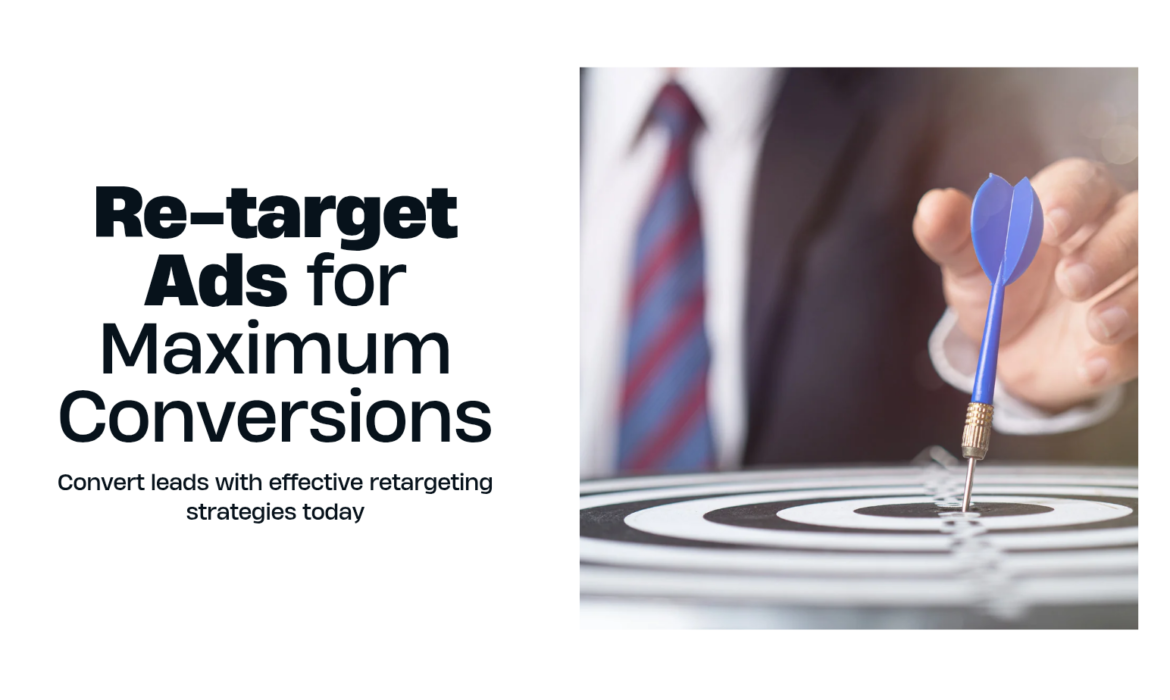081-4797-7173
Retargeting ads is a powerful way to bring back lost leads and convert them into customers. If someone visited your site but didn’t make a purchase, retargeting helps you reconnect with them. This strategy can significantly boost your conversion rates. In this guide, we will explore how to effectively retarget ads and turn lost leads into loyal customers.
Retargeting ads work by tracking visitors who have previously interacted with your website. These visitors may have abandoned their cart, browsed through your products, or signed up for your newsletter. Using cookies, you can display relevant ads to these users as they browse other websites or social media platforms. The goal is to remind them of your product or service and encourage them to complete their purchase.
Retargeting is an essential part of the journey. It keeps your brand in the minds of potential customers. By showing them ads related to what they were already interested in, you increase the likelihood of a conversion.
Building a Retargeting Strategy
A successful retargeting campaign starts with a well-thought-out strategy. First, identify your target audience. Are you aiming for users who have visited your website but didn’t complete a purchase? Or are you retargeting those who abandoned their cart midway through checkout? Knowing your audience’s specific actions will help you craft an effective strategy.
Next, determine the objective of your retargeting efforts. Are you trying to recover lost sales, increase brand awareness, or nurture leads into paying customers? Setting clear goals will help guide your strategy and keep your campaigns focused. For instance, if your goal is to recover lost sales, your ads should focus on reminding users about the products they viewed or added to their cart, and offer a time-limited discount to encourage action.
Another important aspect is deciding the length of time you want to retarget your audience. Typically, users who engaged with your business within the last 30 days are more likely to convert. However, you might want to target people from a longer or shorter time frame depending on your product or service cycle. A longer retargeting period might be useful for high-consideration purchases, while a shorter time frame could be more effective for impulse buys.
Finally, develop a content plan for your retargeting ads. Choose the right visuals and copy to appeal to users. Ensure that the content is relevant to their initial engagement with your brand. For example, if they viewed a specific product, show that product in your ad, accompanied by a compelling offer or incentive to buy.
Personalising Ads for Better Engagement
Personalisation is key to making your retargeting ads stand out and resonate with your audience. The more relevant the ad is to the user’s previous interactions with your brand, the higher the likelihood of converting them into a customer. Start by segmenting your audience based on their behaviour.
For instance, if a user visited your website and spent a considerable amount of time on a product page but didn’t make a purchase, show them ads that feature that exact product. You can also offer a discount or highlight key benefits to encourage them to return. This level of personalisation increases the chances of the user feeling valued, rather than seeing a generic, broad ad that might not feel relevant to their interests.
Additionally, consider personalising the messaging in your ads. Instead of a one for all approach, use language that speaks directly to the individual’s previous experience.This approach addresses their specific action and provides a solution.
Moreover, dynamic retargeting ads, which automatically pull in the products or services the user viewed, are incredibly effective in personalisation. These ads adapt to the individual’s browsing history, creating a seamless and highly relevant experience.
Lastly, retargeting ads can be more impactful when combined with personal offers. For example, offering a personalised discount based on the product a user previously showed interest in can drive them to return to your site. This kind of targeted offer gives the user an extra incentive to click through and complete their purchase.
Effective Platforms for Retargeting Ads
Choosing the right platform for your retargeting ads is crucial for reaching the right audience at the right time. There are several platforms available that offer retargeting features, and each has its unique advantages. Understanding where your audience spends their time will guide your decision.
Google Ads is one of the most widely used platforms for retargeting. With Google’s vast network of search results, YouTube, and partner websites, it allows you to create a highly-targeted retargeting campaign. For example, you can target users who visited specific pages of your website or interacted with certain content. Google Ads also offers flexibility in setting your budget and adjusting the frequency of your ads, making it suitable for businesses of all sizes.
Another effective platform for retargeting is Facebook Ads. Facebook’s advanced targeting features allow you to connect with users based on their interests, demographics, and previous interactions with your brand. Through Facebook, you can run dynamic ads that showcase products users have previously viewed or added to their cart. Additionally, Instagram, being a part of the Facebook network, offers another great space for visual retargeting ads.
LinkedIn is an excellent platform if you’re targeting a B2B audience. It enables you to retarget users based on their professional roles, interests, and company data. LinkedIn’s audience is often in a business mindset, making it an ideal space for offering services or products that cater to professionals.
A/B Testing for Improved Conversion Rates
A/B testing is an essential tool in your retargeting strategy. It allows you to test different versions of your ads to determine which one resonates best with your audience. By experimenting with various ad elements such as headlines, images, call-to-action (CTA) buttons, and copy, you can gather data that helps improve your campaign’s performance.
Start by creating two variations of the same ad but with slight differences. For instance, you might change the CTA from “Shop Now” to “Get Started” or use two different images of the same product. Then, divide your audience into two equal groups and show each version of the ad to one group. This will help you identify which version performs better in terms of engagement and conversions.
Keep in mind that A/B testing is an ongoing process. As you gather more data, you can continue to refine your ads to maximize your conversion rates. Over time, this iterative approach will help you craft ads that are more persuasive and relevant to your target audience.
It’s also essential to test one element at a time. If you test multiple variables at once, it can become difficult to pinpoint what caused any change in performance. Therefore, focusing on testing one element, like the wording of your CTA or the image used, will provide clearer insights.
Optimising Frequency and Timing
Optimising the frequency and timing of your retargeting ads is crucial to ensuring that your ads don’t overwhelm your audience or lose effectiveness. Showing ads too frequently can lead to ad fatigue, where users become annoyed or disengaged. On the other hand, showing ads too infrequently can result in lost opportunities to convert leads into customers.
To strike the right balance, you need to monitor how often your ads are displayed to each user. Most platforms offer frequency capping features that allow you to limit the number of times a user sees your ad within a specific timeframe. This ensures that your audience is exposed to your ads enough times to encourage conversions, but not so often that they become annoyed or fatigued by your message.
Timing is another key factor. Retargeting ads should be shown when your audience is most likely to engage with them. For example, if your product or service is seasonal, showing ads around the peak of the season is crucial. Similarly, understanding your audience’s daily patterns can help you determine the best times to display your ads. If your target audience is primarily working professionals, it may be best to schedule ads during lunch hours or in the evening when they’re more likely to engage with them.
One effective way to optimise timing is by using data from your previous campaigns. Analytics tools can show you when your ads have received the most engagement. By leveraging this data, you can adjust your strategy to show ads at the times your audience is most active.
Converting Retargeted Leads into Customers
The ultimate goal of retargeting ads is to convert lost leads into paying customers. To achieve this, it’s important to understand the specific needs and motivations of the users you are retargeting. By presenting the right offers and messaging, you can increase the likelihood of conversion.
One of the most effective ways to convert retargeted leads is by offering special incentives, such as discounts, free trials, or exclusive content. These offers make the product or service more appealing to users who may have previously shown interest but didn’t take the final step. Personalising these offers based on user behavior (such as browsing specific products) can increase the chances of success.
For example, if a user added a product to their cart but didn’t complete the purchase, sending them a reminder ad that highlights the product they left behind, perhaps with a limited-time discount, can prompt them to finalise the transaction. Additionally, showing social proof, such as customer reviews or testimonials, can help build trust and reduce any hesitation that may have prevented the user from purchasing initially.
Another key strategy is to make the path to conversion as seamless as possible. Ensure that your landing pages are optimised for quick navigation, and that the purchasing process is straightforward and user-friendly. Any unnecessary steps or complicated forms can lead to drop-offs.
Tracking Performance and Adjusting Campaigns
Once your retargeting campaign is live, the next crucial step is tracking its performance and making necessary adjustments. Without continuous monitoring, it’s difficult to determine whether your efforts are leading to actual conversions. Regularly assessing campaign metrics helps you understand what’s working and what needs improvement.
Key metrics to track include click-through rates (CTR), conversion rates, return on ad spend (ROAS), and cost per conversion. These metrics will give you insights into how well your ads are performing and whether they are reaching the right audience effectively.
A/B testing, which we discussed earlier, is also a valuable tool for assessing the performance of different ad variations. By testing different ad copies, visuals, or offers, you can identify which resonates best with your audience. Use the data from these tests to refine your ads and improve overall performance.
Additionally, track user engagement with your landing pages and website after clicking on your retargeting ads. High bounce rates or low time spent on the page may indicate issues with the landing page experience, such as slow loading times or unclear messaging. By addressing these issues, you can improve the overall conversion process.
It’s also important to regularly adjust your retargeting frequency and timing. If users are seeing the same ad too often, they may become irritated or disengaged. Conversely, if they aren’t seeing enough of your ads, they may forget about your brand entirely. Striking the right balance is key to maintaining engagement and driving conversions.
Conclusion
In conclusion, retargeting ads are an essential part of any digital marketing strategy, allowing businesses to re-engage potential customers who have already shown interest. By building a retargeting strategy, personalising ads, leveraging effective platforms, and continuously tracking performance, you can significantly increase your chances of converting lost leads into loyal customers.
The key to success lies in consistently refining your approach, analysing your data, and making adjustments to improve performance. With these steps, you can ensure that your retargeting ads work effectively and efficiently, helping you achieve higher conversion rates and a better return on investment.
Share your thoughts or experiences with retargeting in the comments below. Let’s discuss how you’ve used these strategies to turn lost leads into customers.
0






